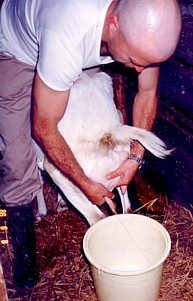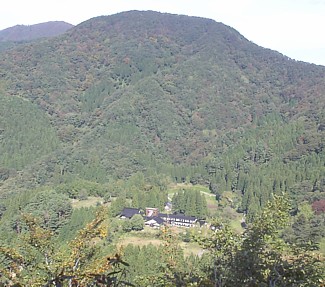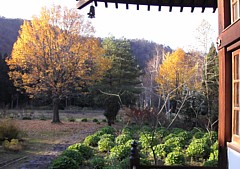|
|---|
 Milking the goat How to sit 11 (Adult practice - Part XXXI) |
Sawaki Rôshi concludes the paragraph on Physical preparations (or "preparing yourself", as it is called in "Shikantaza") with the advice:
"Wash your face and feet so that you feel refreshed." This is a quote from Keizan Zenji's Zazen-yôjinki that literally translates as "always wash your eyes and feet to attain peace and quietude in both body and mind". The feet and eyes are sometimes used as metaphors for practice and realization. That practice and realization must be undefiled is one of the main points of Dôgen Zen. Needless to say, Keizan is not just talking metaphysics here, but actually asking us to wash both the eyes (or the whole face) and the feet to feel refreshed. But in practice, this isn't always as easy as it seems. We saw the Antaiji sesshin schedule in June and it is obvious that there is not much free time during the day, except for a 30 minute break after each of the two meals. Also, there is no bath during the five days of sesshin, although it is possible to take cold showers in the summer, if you have the time. Most monks will not even take a shower during sesshin though. Anyone will have the time to wash their face in the morning when they get up before 4 am and prepare for the first zazen. But it is not easy to find the time and space to wash your feet. It wouldn't be considered to wash them in the sink where people wash their hands and brush their teeth, and if you do not find the time to take a shower, you propably will end up not washing your feet during the five days. When I entered Antaiji as a novice monk 12 years ago, I was appointed as the monk responsible for the two goats that lived here at the time. The female, called Yuki, had to be fed and milked twice a day. She would sleep in the barn, but during the day-time I had to lead her out and tie her to a tree so that she could feed on the grass for some hours, until I would take her back and milk her again in the evening. For some reason, whenever someone milked her, she would try to kick over the bucket or the monk himself with her legs. Using the milking technique that is shown on the picture above has the advantage of disabling the goat to kick the monk while milking, but it also has a disadvantage when the goat defecates during the milking process. It will all be part of the same bucket. Therefore I used the method of putting my head and upper body firmly against her body while approaching her from one side with the bucket directly under her breasts, securing it from her kicks with my left elbow while milking her with both hands. Thus, her droppings would not land in the bucket, but her feet would attack me from the left side, covering me with dirt. After Yuki was taken care of, I would go off to see Tarô, the male. He would always stay outside, but he had to be moved from one tree to the next from time to time. Often he got entangled in his rope, and had to be freed. Yuki could be kind of moody at times, but Tarô was always aggressive. Maybe it was the smell of his mate on me which made him furious. Anyway, I always had a hard time protecting myself from the attack of his horns with one hand while doing my best with the other to liberate him from his entanglement in the rope. Tarô was not only stronger than Yuki, he also had a more intensive smell, and by the time I got back with my bucket to the kitchen, I was not only smelling of my own sweat! Once I was finished with both of them, the only job left was to sterilyze the milk by boiling it on the kitchen stove, then filling it into bottles and putting it into the refrigerator. During sesshin, there were only 30 minutes for the whole job, and it goes without saying that I was always in a hurry to get back to the zendô in time for the next sitting. Although I myself and also the monks sitting close to me would have loved me taking a shower, there wasn't even the time to brush my teeth after the meals. Again, as we have seen with the other points to take care of when preparing for zazen, the "perfection of patience" is important, as the situation will usually be far less than ideal for practicing zazen. After the five days of sesshin, my whole body, my robes, my sitting cushion and the bedding in my room would all smell like goats do. It was only after the bath on the night of the fifth day that I would feel refreshed in body and mind indeed!
(to be continued - Docho)
|
|---|
 |
 |
|---|
 |
 |
 |

The Aum cult isn't the real problem |
"The teaching of Aum seems to be Buddhism at first sight, but in reality it isn't Buddhist at all. ...it is a mixture of many different religions with Indian philosophy at the basis, arranging the concepts of Buddhism that are so familiar to the Japanese in a modern way." With these words "The point of view the Soto school takes on Aum - Questions and answers" (in Japanese) begins. In contrast to the Rinzai school, that during its history had been supported mainly by the aristocratic class in the capital, the Soto school spread among farmers during the Japanese middle ages, and today - with more than 15.000 temples - is proud to be the largest among the Japanese Buddhist sects. One might expect that unlike the elite-oriented and sometimes arrogant Rinzai Zen, Soto would embrace those in need for spiritual guidance with a bigger mind and broader perspective. Unfortunately, this is not the case. The Soto school does not understand Aum as "our own problem", and it also does not seem to be interested in saving its lost followers. But the main problem of Japanese Buddhism is not the Aum cult. If we want to invest the Aum incident, we can not avoid taking a critical look at the state of our own school as well. The aim of this "Ten years after Aum" series is not so much to invest Aum itself, but rather to question the content of our own belief and practice. If we take an honest look at this practice, we might find that Soto Zen just as most of the rest of Japanese Buddhism "seems to be Buddhism at first sight, but in reality isn't Buddhist at all" - being a mixture of several popular religions and pagan beliefs, dressed in Buddhist terminology. If this should be the case, it is indeed "our problem" and Aum is only a by-product of it. Therefore, I would like to check the "The point of view the Soto school takes on Aum" by applying it not to Aum but to the theory and practice of the Soto school itself. Once more: The question is not if Aum is Buddhism or not, but if we who say that Aum isn't true Buddhism are true Buddhists ourselves, or not? For this, we have to clarify what "true Buddhism" is supposed to mean in the first place. I think the reason why cults like Aum thrive, and the reason why sects turned into money-making organizations like most or all of the established Japanese Buddhist sects (including Soto, Rinzai and Obaku) continue to exist is just that no-one has ever thought deeply about what Buddhism really is. Most simply agree that Buddhism is a funeral buisiness, and those who look for more are left as the pray of dubious cults. It should go without saying that the Buddhist teaching (the dharma) is nothing other than the Buddha's teaching, i.e. the truth that Shakyamuni awakened to 2500 years ago. How come that this simple fact has been forgotten, and the lives of the Japanese priests have deviated so far from the dharma!? It can not possibly be that I am the only one who asks himself this question. Anyway, let us examine what Buddhism is, and what only seems to be Buddhism at first sight, but in reality is nothing more than fake.
to be continued ... (Muho)
|
|---|

|
 |
|---|
